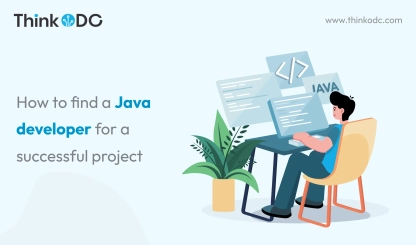Transforming to the cloud or adopting modern solutions is what everyone’s preaching these days. But new technology comes with new challenges. Despite its major benefits of scalability, cost-effectiveness, or faster deployment, serverless architecture has its own drawbacks such as Vendor-lock-ins, cold start & many more. To overcome these hassles experienced developers have found alternative options or loopholes to fit in. However, issues remained constant until a new framework called Micronaut landed in the market.
Micronaut is an open-source JVM-based framework that is popular for building lightweight serverless Java applications. And it's pair-buddy AWS Lambda which is an event-driven serverless compute service from Amazon, allows Java developers to run code for any type of application or backend services without provisioning or managing servers. Isn’t that a great mix?
In this blog, you will learn about the major challenges of serverless architecture & their solutions, how Java is a better choice for serverless, and case studies proving the benefits of serverless architecture are real. Ready for such revolutionary stuff?
But first, let's look at data showing the hyped-up trend of serverless architecture adoption in companies worldwide.
Serverless architecture growth worldwide
If you thought, serverless is playing just a small role in modern software solutions, these mind-boggling stats are for you.

The global serverless architecture market size was valued at USD 11.38 billion in 2023 and is estimated to reach around USD 106.12 billion by 2033 according to the Precedence research report.
As shown above, it’s quite obvious businesses are ALL-IN for serverless architecture and continue to invest largely for the coming 2033. Therefore finding the best ways to adopt serverless architecture and to continue Java high-performance app development, you should be aware of all the major challenges and their respective solutions for successful app development.
Challenges of Serverless applications with solutions
Serverless applications are the most modern approach towards app development, but they also possess hindrances that trouble many new-age companies & IT business owners. Here are some common issues companies face, along with solutions provided by AWS Lambda & Micronaut(Java framework):
1. Cold start times:
The Initial execution of a serverless function can be slow due to "cold start" delays, that extensively impact performance related to the infrequently invoked functions.
Solution: Micronaut's AOT (Ahead-of-Time) compilation capabilities can pre-compile Java functions into native binaries, which ultimately minimizes cold start times.
2. Vendor lock-in:
Vendor lock-in refers to situations when you want to switch your cloud providers, but migrating from one to another becomes a struggle because serverless architecture from one cloud provider requires major code changes in switching to another. And being stuck with only one provider limits flexibility and potentially increases costs over time.
Solution: Micronaut is a cloud-agnostic framework whereas Lambda is an AWS service. This unique combination allows companies to potentially explore other serverless providers in the future without rewriting code from scratch.
3. Debugging difficulties:
Serverless architectures have a distributed nature due to which debugging them can be more complex compared to traditional deployments.
Solution: Micronaut provides built-in features like hot reloading and trace logging, which can simplify debugging processes and identify issues within functions more efficiently.
Surely, the above reasons make AWS Lambda with Micronaut a killer combination for serverles Java app development amongst skilled Java developers. Along with that the benefits of Micronaut for serverless applications keep this legendary loop going, leading to faster & better app development cycles.
Benefits of Micronaut used for serverless apps
Along With serverless architecture keeping businesses happy with its numerous pros, Micronaut also serves incredible boosting capabilities that rectify all the emerging issues of serverless applications. Here are some of the pros of using Micronaut for serverless Java apps:

-
Lightweight & fast: Micronaut has a small footprint and is known for its performance that suits ideally for serverless environments.
-
Cloud agnostic: Micronaut can run on various cloud platforms, including AWS Lambda, avoiding vendor lock-in for business owners.
-
AOT compilation: Micronaut can give pre-compiled Java functions that further convert into native binaries, dramatically reducing cold start times that prove to be a major pain point with serverless.
-
Mature framework: Micronaut offers a stable and feature-rich framework for building modern Java high-performance applications.
Why choose Java for serverless applications?
There’s no doubt that serverless architecture can be constructed with many other modern-day programming languages such as Groovy or Kotlin. Then why do developers prefer Java for high-performance serverless applications? Let’s understand this through the following table:
| SNo | Aspect | Java | Groovy | Kotlin |
|---|---|---|---|---|
| 1 | Cold-start times. | Better cold start times with GraalVM and Micronaut. | Longer cold start times compared to Java. | Similar to Java but only when used with Micronaut & GraalVM. |
| 2 | Performance and efficiency | High performance and efficiency, especially for long-running applications | Slower performance due to dynamic nature. | Performance close to Java through JVM optimizations. |
| 3 | Maturity and stability | Mature and stable ecosystem. Hence widely adopted for critical applications. | Mature ecosystem but is less stable and performant compared to Java. | Modern language with growing adoption but not as much as Java |
| 4 | JVM optimizations | Heavily optimized JVM, benefiting Java directly. | Runs on the JVM, but optimizations are more tailored to Java. | Benefits from JVM optimizations performance close to Java. |
| 5 | Tooling and framework support | Huge support in IDEs and build tools like Maven and Gradle. Micronaut & GraalVM for native image support available. | Good support in IDEs and build tools like Gradle. Supports Micronaut but lacks the native image capabilities of GraalVM. | Excellent support in IDEs like IntelliJ IDEA and build tools like Gradle. Supports Integration with Micronaut & GraalVM for native images. |
As stated in the table, Java being the OG of the developer community, offers high performance & significant reduction in cold start times along with many other features that make it a perfect fit for serverless application development projects. However, you also need to hire experienced Java developers to accomplish the best practices for Java with AWS Lambda & Micronaut combination.
It's not impossible guys! Many companies have already reaped the benefits of serverless Java, which you can explore through the following case study examples.
Case study: Serverless Java with AWS Lambda & Micronaut

Case Study 1: Caribou
It is a SaaS application that works with the engineering team for technical debt reduction. They were seeking frameworks that could boost their development speed. They wanted to get an MVP out quickly and then continue the same from there based on user feedback.
Impact: Through the combination of Micronaut and GraalVM technology in AWS Lambda they were able to recognize huge competitive advantages through the reduction in cold startup time to only 1.5 to 2 seconds.
Case Study 2: SmartThings
It is a subsidiary of Samsung Electronics, that offers consumers at-home IoT products like sensors, smart devices etc. They were stuck with a legacy system that couldn’t keep up with the requirements of its popular smart-home devices.
Impact: Utilizing the Micronaut framework they were able to achieve- consolidated servers, increased workload efficiency in the cloud, shorter development cycles, and reduced and better-controlled costs all through a slight shift towards serverless architecture.
Case Study 3: Disney
Who wouldn’t have heard this name in their lifetime? And if you didn't, it seems like your childhood was tough. This entertainment giant also had trouble with memory allocation and slow cold start time due to the need to load multiple classes and libraries into memory during startup. It was a huge issue for Disney as they wanted quick response times.
Impact: With the use of AWS Lambda with Micronaut framework they were able to increase memory allocation from 512 MB to 3008 MB and reduce cold start duration from 6.3 seconds to 3.6 seconds just by running on the JVM. Additionally, with the use of GraalVM's framework same Lambda function with 3008 MB of memory that initially took 3.6 seconds to start, now started in 100 milliseconds using GraalVM's native-image tool.
ThinkODC: Choose us to get started with serverless Java
Do you want to jump into a serverless Java application but feeling lost? ThinkODC is your launchpad! Our seasoned Java developers are experts in modern solutions like serverless architecture and AWS tools (CDK, Lambda). We'll guide you through building efficient, scalable Java applications with the latest advancements.
Don't wait, buckle up with Micronaut & power your serverless Java with ThinkODC today!
Wrap up
The combination of AWS Lambda and the Micronaut framework surely addresses many advanced struggles, companies face even after adopting modern solutions. Major challenges faced by Java-based serverless applications, such as cold start latency, high memory usage, and scalability can be easily solved under the proper guidance of Java experts & a reliable off-shore development company like us. With our expertise in Java app development and use of GraalVM, provisioned concurrency, and powerful integration capabilities, we can optimize your serverless applications for unbeatable performance and cost-efficiency.





